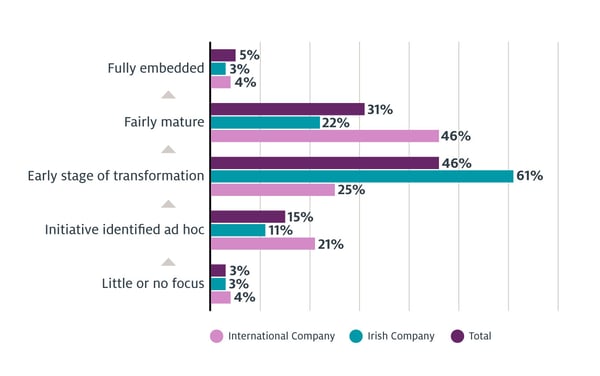Customer Experience (CX) maturity models (Forrester, Temkin, Gartner etc) provide a useful framework for organisations to assess progress on their customer centricity journey. They are a useful tool when looking for signposts as to where to direct efforts.
In our recent survey exploring the State of CX management in Ireland on behalf of CXPA Ireland, we asked participants to ‘self-assess’ their organisation’s maturity along a five-point maturity scale from ‘no focus on CX’ to ‘fully embedded CX programme’. Just over a third (35%) of participants described their organisations as having either a ‘fairly mature’ or a ‘fully embedded’ CX programme, with only 4% citing ‘no focus’. That the majority of organisations are at least looking at leveraging CX to some degree is encouraging.
Within the 35% of ‘more mature’ organisations we found differences between respondents working in Irish organisations and those working in international businesses with operations in Ireland. Half (50%) of respondents working in international businesses with operations in Ireland described their organisations as having a ‘fairly mature’ or ‘fully embedded’ CX programme compared to just 25% working in Irish businesses.
Furthermore, a majority (61%) of respondents in Irish businesses described their organisations as still in the early stages of maturity compared to a quarter (25%) of those in international businesses.
It’s perhaps not surprising that organisations operating across borders and countries are more likely to be ‘further along the CX curve’ given the likelihood of greater customer pressures and exposure to global competition.

We also looked at several other hallmarks of customer centricity and maturity. For example, having a clearly articulated CX vision, CX strategy, clear ownership of CX and a visible roadmap of initiatives. In almost all cases respondents in international businesses stated these were more clearly articulated in their organisations compared to their counterpart practitioners in Irish businesses.
The gap between Irish and international businesses was widest in terms of ‘ownership and responsibilities for CX’ with 29% of participants in international businesses indicating this was clearly articulated in their organisations compared to just 8% in Irish organisations.
Customer KPIs embedded in employee goals is clearly articulated in 29% of international business compared to only 19% of Irish businesses.
Given that organisational silos and ownership for CX were identified as the biggest obstacles to gaining traction for CX by respondents in our survey, this suggests an urgent need for CX practitioners in Irish businesses in particular to address the imperative of securing clear ownership and accountability for CX.
How to explain that one curious outlier - CX strategy? When asked about CX strategy (which we defined as how clearly the organisation delivers on its vision) all respondents, regardless of where they worked, felt the same way - only 17% believed this was clearly articulated and visible in their organisations.
One possible explanation for this relatively low percentage is that 29% of those working in international businesses say their CX strategy is decided at ‘C-suite’ or in ‘head office’ compared to 11% of respondents in Irish businesses. Irish CX Practitioners in international businesses are less likely to be articulating the strategy themselves than their Irish counterparts. This suggests that international organisations face the additional challenge of communicating the strategy successfully across cultures and countries.
For help on assessing or diagnosing your organisation’s CX maturity or where to next on your journey, please contact us.

